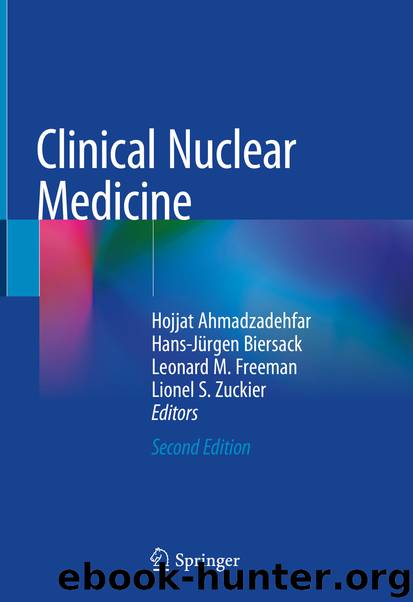Clinical Nuclear Medicine by Unknown

Author:Unknown
Language: eng
Format: epub
ISBN: 9783030394578
Publisher: Springer International Publishing
17.1.2 Motion Artifacts
Motion artifacts are typically presented as blurring in PET or as misalignment between PET and CT data sets, which can lead to both spatial localization errors and incorrect attenuation correction [4]. The dimension of artifacts is mainly dependent on the number and spatial range of motion and the duration of acquisition. PET acquisition is usually performed by a series of consecutive bed positions of 15–20 cm with a duration of 2–3 min each. Therefore, motion particularly causes artifacts image in motion-affected regions. In contrast, the separately acquired helical CT scan acquires 15–20 cm in a few seconds, and motion-affected regions are usually obtained in a locally motion-free state [4].
Motion can be considered as either voluntary (e.g., head motion) or involuntary (e.g., cardiac contraction or respiratory motion). Artifacts can be developed by motion occurring during either the PET or the CT acquisition or from motion that occurs between the two acquisitions.
Patient movement may cause poor-quality and blurred PET images and regions of increased or decreased activity mainly due to incorrect attenuation correction. In addition, PET artifacts can result from erroneous scatter correction if the tracer distribution is not correctly adjusted with the CT due to regions of activity being incorrectly defined as scatter. Changing scatter correction parameters can often reduce this artifact. In addition, good communication with the patient, attention to careful positioning, physical supports, and occasionally, sedation may limit voluntary motion. However, careful inspection of PET/CT images to identify when motion has occurred is probably the most useful method to repeat local imaging when needed.
Involuntary motions causing artifact by respiratory-induced spatial misalignment between PET and CT data sets are potentially more difficult to control. It usually happened at the base part of the lung and the anterior wall of the heart and can lead to attenuation-correction errors and degrading of lesion detection and tumor quantitation (Fig. 17.1) [6–8].
Fig. 17.1 18F-FDG PET (coronal view). Motion artifact. Involuntary motions causing artifact by respiratory-induced spatial misalignment between PET and CT data sets on the base of the lung, so-called mushroom sign, banana sign (arrows)
Download
This site does not store any files on its server. We only index and link to content provided by other sites. Please contact the content providers to delete copyright contents if any and email us, we'll remove relevant links or contents immediately.
Sass and Compass in Action by Wynn Netherland Nathan Weizenbaum Chris Eppstein Brandon Mathis(13265)
Autodesk Civil 3D 2024 from Start to Finish by Stephen Walz Tony Sabat(7409)
Mathematics for Game Programming and Computer Graphics by Penny de Byl(7310)
Taking Blender to the Next Level by Ruan Lotter(7124)
Express Your Creativity with Adobe Express by Rosie Sue(6911)
Hands-On Unity 2022 Game Development - Third Edition by Nicolas Alejandro Borromeo(6571)
Hands-On Unity 2022 Game Development by Nicolas Alejandro Borromeo(5232)
Unreal Engine 5 Character Creation, Animation, and Cinematics by Henk Venter & Wilhelm Ogterop(4124)
Going the Distance with Babylon.js by Josh Elster(4083)
Squeaky Clean Topology in Blender by Michael Steppig(4005)
Mastering Graphics Programming with Vulkan by Marco Castorina & Gabriel Sassone(3976)
Adobe Illustrator for Creative Professionals by Clint Balsar(3776)
Drawing Shortcuts: Developing Quick Drawing Skills Using Today's Technology by Leggitt Jim(3037)
Unreal Engine 5 Character Creation, Animation, and Cinematics by Henk Venter Wilhelm Ogterop(2942)
Rapid Viz: A New Method for the Rapid Visualization of Ideas by Kurt Hanks & Larry Belliston(2869)
The 46 Rules of Genius: An Innovator's Guide to Creativity (Voices That Matter) by Marty Neumeier(2817)
Learn Qt 5: Build modern, responsive cross-platform desktop applications with Qt, C++, and QML by Nicholas Sherriff(2494)
Fusion 360 for Makers by Lydia Sloan Cline(2334)
Realistic Asset Creation with Adobe Substance 3D by Zeeshan Jawed Shah(2254)
